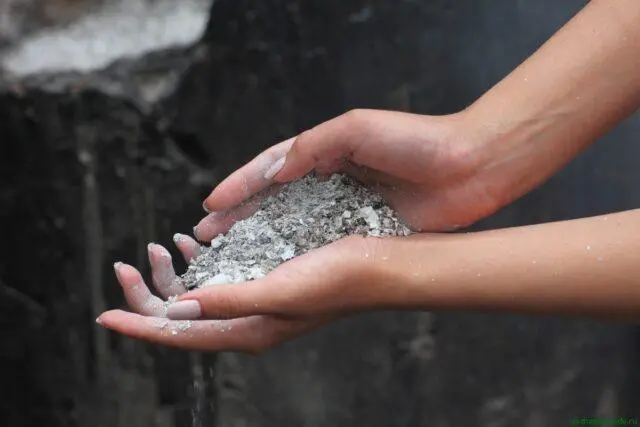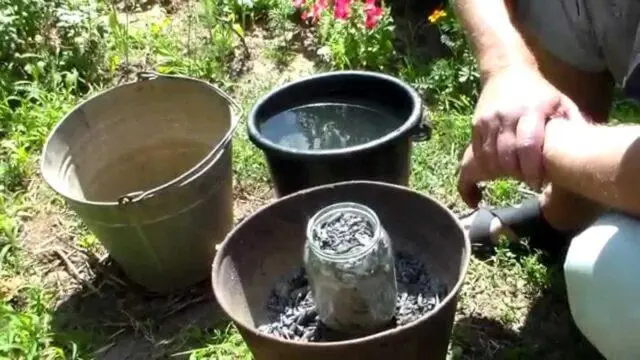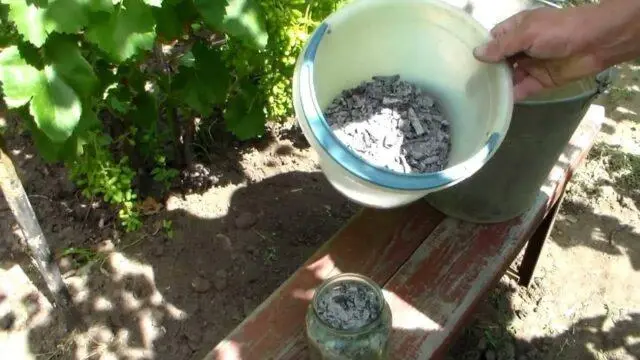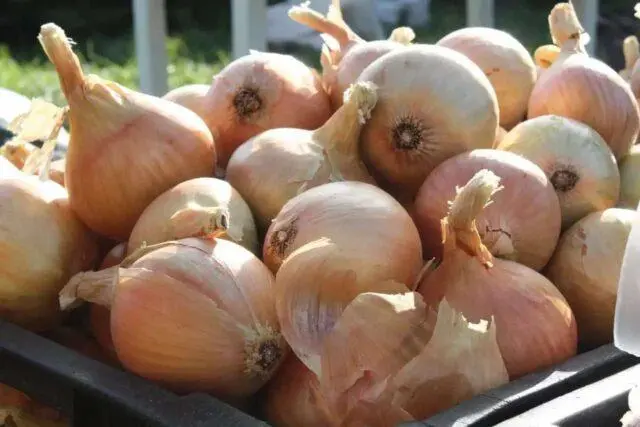Contents
Top dressing of onions with ashes can be carried out no more than twice per season. The procedure is planned a few months before planting sevka or seeds. Top dressing is applied while digging the soil. If this is not done, the fertilizer is placed in the furrow directly at planting. Also, the composition is used for the prevention of diseases and the destruction of onion flies and other pests.
The benefits and harms of ash for onions
Many gardeners believe that onions love ashes. This is a correct opinion, proven by many years of experience. The systematic use of top dressing is of great benefit to both plants and soil:
- Improvement of soil structure.
- The powder does not contain chlorine, which is dangerous for plants.
- Wood ash reduces acidity, so it is especially effective on highly acidic soils.
- Onions adapt better to temperature changes, frosts. This is especially important for the Urals, Siberia, and the Far East.
- Once harvested, onions have a longer shelf life.
- Infusion and wood ash powder protects onion plantings from pests and diseases.
- Top dressing has a completely natural composition, so in moderation it does not pose a danger to humans, plants, insects, soil bacteria.
- Wood ash is valuable because you can get it yourself as a product of burning birch and other firewood (plants should not be used).
Feeding can be harmful. It is safe in moderation. But if you use the powder too often, the acidity of the soil decreases. At some point, the pH may exceed 7,0, causing the soil to become alkaline. In this case, the yield of almost all crops will decrease.
When using the product, you need to carefully monitor the dosages. You should not get carried away with too frequent fertilization – otherwise it will do more harm than good. This is especially important when the exact pH of the soil is not known, and also if saline soils predominate in the region.

Fertilizer should be used in moderation
It is worth considering that the acidity decreases gradually. This process takes several years and is difficult to track in practice. Therefore, it is desirable to control the acidity index by periodically measuring with a pH meter.
Ash and ready-made fertilizers (differences)
Wood ash is a complex fertilizer for onions and other plants. It consists of such components: salts of calcium, magnesium, sodium, potassium phosphate.
It differs from ready-made fertilizers that can be purchased at the store in several ways:
- Variable composition, depending on the type of wood, the completeness of combustion.
- Appearance (powder of a fine fraction, may include larger, unburned fragments).
- The complete absence of nitrogen – during combustion, it quickly combines with atmospheric oxygen and evaporates.
The composition of the ash is very rich, and in this parameter top dressing is in no way inferior to conventional fertilizers. However, it lacks nitrogen, so onions must be given urea, ammonium nitrate. At the same time, the absence of nitrogen can be considered a plus. The fact is that ash can be given at any time, and nitrogen-containing compounds – only in the early stages of growth (second half of spring, early summer).
When to use onion ash
Fertilizer is applied to the soil no more than twice per season. To do this, you can choose the following dates:
- Seal the powder while digging the soil when preparing the site in the fall or spring (a few months before planting a set or seeds).
- If this has not been done, apply top dressing immediately before planting, sprinkling a thin layer on the bottom of the furrows. Fertilizer is sprinkled with soil.
- Water the plantings with infusion a few days after the mass emergence of shoots.
- Foliar treatment for disease prevention can be carried out at about the same time.
- Repeated procedures are done only if necessary (when signs of fungal infections or pests appear).
- After harvesting the onion into the soil, wood ash can also be embedded. This is done only if fertilizer has never been applied during the season.

Enrich the soil with natural composition no more than twice per season
How to use onion ash
You can feed onions with ashes using different recipes. Dosage, timing of application and quantity depend on the purpose of feeding.
For top dressing
Most often, wood ash is used as a natural fertilizer for onions. There are several recipes, the most effective of them:
- Scatter the ashes over the bed with a thin layer (a glass of 1 m2). This procedure can be repeated 2-3 times per season before abundant watering or on the eve of rain. Then the nutrients will quickly dissolve, enter the soil and be absorbed by the onion roots.
- Take 250 g of wood ash and insist in 10 liters of water at room temperature for three days. After that, onion plantings are abundantly watered.
- 500 g of powder is poured into a bucket of water. Insist for seven days. Then water the onion plantings. Take into account the ratio: 0,5 l of solution for each plant.
Also, ash for feeding onions can be used as part of other fertilizers. Summer residents recommend using the following recipes:
- They take a three-liter jar and put 5 tbsp. l. sugar, 15 g fresh or dry yeast (1 tbsp without a slide), 1 tbsp. l. ash and pour to the top. You need to insist for at least three days, after which you need to water all the onion plantings.
- Mow the field grass, chop it and fill up to a third of the bucket. Add 100-150 g of ash. Pour in water, insist for two weeks. The resulting volume is diluted 10 times and watering is started.
- You can also prepare a complex organic fertilizer with mineral elements. To do this, 10 g of fresh and 250 g of rotted manure are placed in a 500 l bucket, 50 ml of kefir or yogurt and 150 ml of mash are added, 150 g of ash are poured. Leave to ferment for a week, then water the onion once with a solution diluted twice.

The infusion is kept for at least two days
From diseases and pests
Wood ash helps not only in prevention, but also in the treatment of dangerous onion diseases (powdery mildew, gray and bacterial rot). For processing, it is recommended to powder the beds with wood ash a few days after germination. Another recipe is used when signs of diseases or pests appear (onion fly, moth, thrips, and others):
- Measure out 300 g of powder.
- Pour into a 10 liter bucket.
- It is necessary to get a shaving of laundry soap (50 g) and add it there.
- Stir and let stand for at least 24 hours.
- Pour into a sprayer and process all landings.
Preparing onion sets and seeds for planting
In the spring, ash is brought under the onion sets. If the soil was not previously fertilized with this top dressing, several grooves 5-7 cm deep are formed on the bed and powder is poured to the bottom, and a small layer of fertile soil is on top. As a result, sets or seeds will immediately receive valuable fertilizer, thanks to which they better adapt to temperature changes. The ash will reliably protect the onion from rot.
Ash when planting onions
Wood ash can also be applied before planting onions or other crops. The site begins to be dug up in 1-2 months or on the eve of autumn, if they plan to plant at the beginning of the season. When digging, the soil is abundantly sprinkled with ash in the amount of 500-600 g per 1 m2. If the soil is depleted, you can add compost or humus in the amount of 5 kg to the same area.
For storage
For long-term storage, the bulbs are laid out in boxes in several layers and sprinkled with wood ash. The quantities should be small – just enough to powder, evenly distributing the powder between all layers. This protects the crop from mold and other diseases.

Ash helps keep onions from mold
gardeners mistakes
It is not difficult to add ash for planting onions or use it for treatment from pests and diseases. But sometimes even experienced gardeners make mistakes. To avoid them, it is recommended to follow these rules:
- You should not think that if wood ash has a natural composition, then you can use it for onions in any quantity. Fertilizer can only be applied in certain doses.
- If the soil has a neutral or slightly alkaline reaction (saline soils with a pH greater than 7,0), it is not recommended to use ash for onions and other plants. The fact is that it alkalizes the soil. Therefore, it is necessary to periodically add 9% vinegar to the soil in the amount of 100 ml per 10 liters (this is enough for watering 1 m2).
- The bulbs should not be in direct contact with the fertilizer when planting. A high concentration of nutrients is harmful to the plant and can “burn” it. Therefore, when planting at the bottom of the grooves, ash is poured, and then a layer of soil is necessarily laid, and sevok or seeds are already planted in it.
Conclusion
Feeding onions with ash contributes to a better adaptation of the crop to adverse weather conditions, frosts on the soil. When applying, it should be noted that it gradually reduces the acidity and contributes to the alkalization of the soil. Therefore, it is necessary to use the remedy in reasonable quantities. If in doubt, it is better to additionally measure the acidity of the soil with a pH meter.









